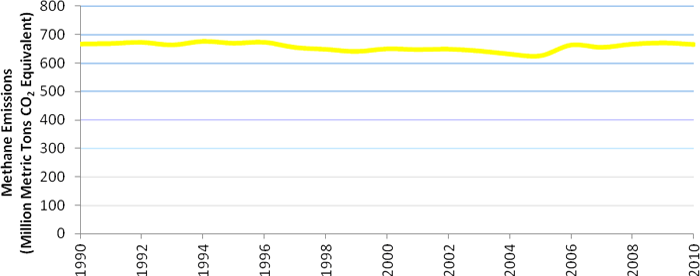Climate Change
Greenhouse Gas Emissions
Methane Emissions

| Chemical Formula | CH4 |
| Lifetime in Atmosphere | 12 years |
| Global Warming Potential (100-year) | 21 |
U.S. Methane Emissions, By Source

Note: All emission estimates from the Inventory of U.S. Greenhouse Gas Emissions and Sinks: 1990-2010.
Methane (CH4) is the second most prevalent greenhouse gas emitted in the United States from human activities. In 2010, CH4 accounted for about 10% of all U.S. greenhouse gas emissions from human activities. Methane is emitted by natural sources such as wetlands, as well as human activities such as leakage from natural gas systems and the raising of livestock. Natural processes in soil and chemical reactions in the atmosphere help remove CH4 from the atmosphere. Methane's lifetime in the atmosphere is much shorter than carbon dioxide (CO2), but CH4 is more efficient at trapping radiation than CO2. Pound for pound, the comparative impact of CH4 on climate change is over 20 times greater than CO2 over a 100-year period.
Globally, over 60% of total CH4 emissions come from human activities. [1] Methane is emitted from industry, agriculture, and waste management activities, described below.
- Industry. Natural gas and petroleum systems are the largest source of CH4 emissions from industry in the United States. Methane is the primary component of natural gas. Some CH4 is emitted to the atmosphere during the production, processing, storage, transmission, and distribution of natural gas. Because gas is often found alongside petroleum, the production, refinement, transportation, and storage of crude oil is also a source of CH4 emissions. For more information, see the Inventory of U.S. Greenhouse Gas Emissions and Sinks sections on Natural Gas Systems and Petroleum Systems.
- Agriculture. Domestic livestock such as cattle, buffalo, sheep, goats, and camels produce large amounts of CH4 as part of their normal digestive process. Also, when animals' manure is stored or managed in lagoons or holding tanks, CH4 is produced. Because humans raise these animals for food, the emissions are considered human-related. Globally, the Agriculture sector is the primary source of CH4 emissions. For more information, see the Inventory of U.S. Greenhouse Gas Emissions and Sinks Agriculture chapter.
- Waste from Homes and Businesses. Methane is generated in landfills as waste decomposes and in the treatment of wastewater. Landfills are the third largest source of CH4 emissions in the United States. For more information see the U.S. Inventory's Waste chapter.
Methane is also emitted from a number of natural sources. Wetlands are the largest source, emitting CH4 from bacteria that decompose organic materials in the absence of oxygen. Smaller sources include termites, oceans, sediments, volcanoes, and wildfires.
To find out more about the role of CH4 in warming the atmosphere, and its sources, visit the Causes of Climate Change page and the Greenhouse Gas Indicators page in the Science section.
Emissions and Trends
Methane (CH4) emissions in the United States decreased less than 1% between 1990 and 2010. Emissions increased from sources associated with agricultural activities and exploration and production of natural gas and petroleum products. However, these increases were offset by emission reductions over the same time span associated with the capture of CH4 at landfills and improved efficiency in the production and distribution systems for natural gas.
U.S. Methane Emissions, 1990-2010

Note: All emission estimates from the Inventory of U.S. Greenhouse Gas Emissions and Sinks: 1990-2010.
Going forward, CH4 emissions are expected to increase by about 8% between 2005 and 2020. The increase is based on projections of increases in the use of natural gas. The increase in emissions from natural gas is expected to be partially offset by more effective capture of CH4 from landfills, coal mines, and animal waste management systems. [2]
Reducing Methane Emissions
There are a number of ways to reduce methane (CH4) emissions. EPA has a series of voluntary programs for reducing CH4 emissions. Some examples are discussed below.
| Emissions Source | How Emissions Can be Reduced |
|---|---|
|
Industry |
Upgrading the equipment used to produce, store, and transport oil and gas can reduce many of the leaks that contribute to CH4 emissions. Methane from coal mines can also be captured and used for energy. Learn more about the EPA's Natural Gas STAR Program and Coalbed Methane Outreach Program. |
|
Agriculture |
Methane can be reduced and captured by altering manure management strategies at livestock operations or animal feeding practices. Learn more about these strategies and EPA's AgSTAR Program. |
|
Waste from Homes and Businesses |
Because CH4 emissions from landfill gas are a major source of CH4 emissions in the United States, emission controls that capture landfill CH4 are an effective reduction strategy. Learn more about these opportunities and the EPA's Landfill Methane Outreach Program. |
References
1. EPA (2010). Methane and Nitrous Oxide Emissions from Natural Sources . U.S. Environmental Protection Agency, Washington, DC, USA.
2. U.S. Department of State (2007). Projected Greenhouse Gas Emissions. In: Fourth Climate Action Report to the UN Framework Convention on Climate Change . U.S. Department of State, Washington, DC, USA.

